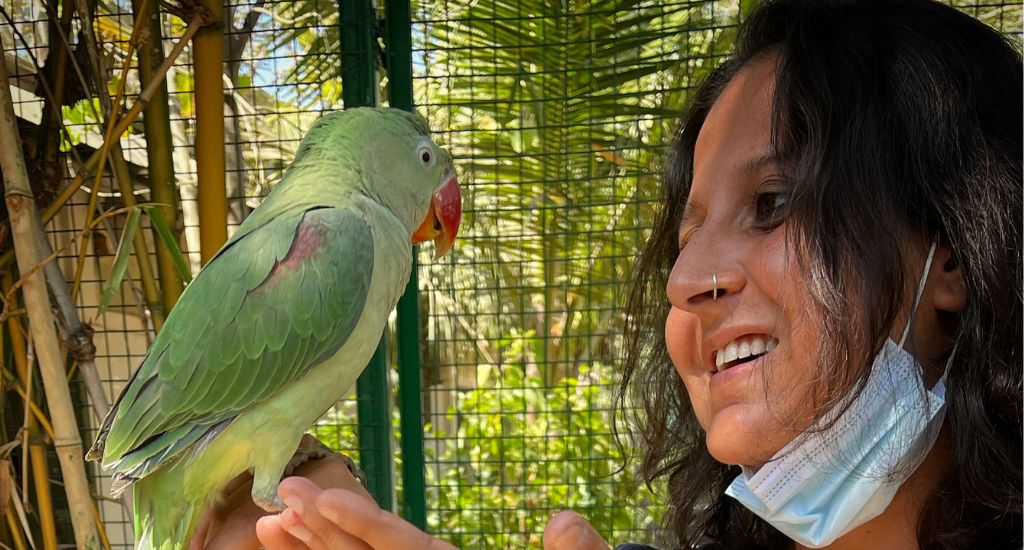
Bird feathers flocked together at this Gujarat library
Esha Munshi of Ahmedabad runs a rare online library that serves as a unique repository on birds and their feathers.

Esha Munshi of Ahmedabad runs a rare online library that serves as a unique repository on birds and their feathers.
We all know that birds of the same feather flock together. But what happens when only the feathers flock together?
Well, you get a ‘Feather Library’.
Courtesy Esha Munshi, a 35-year-old Ahmedabad-based architect with an insatiable thirst to know more about the winged animals adapted for flight, there is a digital library that hosts all kinds of information on birds’ feathers now.
Though many could be excused to think of it initially only as a flight of fancy that would never bear fruition, Munshi has the library up and running with Sherwin Everett, a veterinarian and curator at a bird’s hospital in Ahmedabad.
Interestingly, Munshi’s quest to find out more about birds’ feathers was ignited while she was stranded at home during the Covid lockdown.

“On a random afternoon, one of my cats attacked an Indian silverbill caught in the protective netting of my balcony. I hastily rescued the bird from my cat, but some of its feathers got damaged. Though the bird managed to instantly fly away, its primary feathers were stuck on my palm,” she recounted.
The delicate structure and exquisite patterns of the feathers intrigued her. It prompted her to find out more about the plumage only to realise that there was little or no information on the internet on them.
Data on the feathers of Indian birds is supposedly scarce despite the country having a unique and diverse avian population. There exists detailed information on birds dating back to the pre-1970 era, but after the Wildlife Protection Act of 1972 came into existence, ‘round skin’ specimens – the traditional method of preserving dead birds – were prohibited even for scientific research.
Those that are in museums are kept with their wings folded and dried up which makes it impossible to see the details of individual feathers.
It was then she decided to create a web catalogue, specifically, for feathers. The online ‘Feather Library’ took off in November 2021.

For that matter, Munshi had been interested in birds since 2013 when she spotted a rare black-crowned night heron while standing on the terrace of her office.
“I have been breathing birds since then,” she said. In the 10 years, she has spotted around 1,060 of 1,400 bird species in India by going on countless birding trips across the country.
Her quest to spot birds made her realise that many birds also die terrible deaths, run over by speeding vehicles or cut by strings during kite festivals.
Since the dead birds were normally thrown away in the gutter or burnt, she realised that important dataset was being lost every day.
With the help of the authorities, she then began collecting the feathers of the dead birds and digitising them. So, started the first online collection of birds’ feathers in India.
It provides detailed information on the dead bird’s weight, body length, beak width, wingspan and number of feathers, and the bird’s location.

Believing that the library could be a great resource for different stakeholders like birders, researchers and students, Munshi has applied for requisite permission from other states such as Karnataka, Arunachal Pradesh, Maharashtra and Assam to collect feathers.
“I think it’s all about tying up with the birds’ hospitals and utilising the dead birds’ plumage to maintain a record. It is good for wildlife conservation as well,” she added.
Preserving and digitising feathers is not an easy job though. The dead birds are refrigerated for 48 hours to kill pathogens. Then they are sanitised and their measurements noted. The wings and tail are cut, injected with spirit, and dried. The feathers are counted and logged, while one wing is fully stretched to be photographed.
Interestingly, her Feather Library is among the very few repositories of plumages across the globe. There is one Featherbase – an independent library in Germany, and Feather Atlas – an image database managed by the US Fish and Wildlife Service.
Meanwhile, Munshi hopes to keep on documenting various kinds of bird feathers and make the digital record readily accessible to everyone. “In the end, it’s all about giving back to science,” she said.
The lead image shows the founder of the feather library, Esha Munshi holding a parrot (Photo by Esha Munshi)
Jyoti Thakur is an independent journalist based out of Delhi. She covers gender, environment and social justice. She is a Rural Media Fellow 2022 at Youth Hub, Village Square.